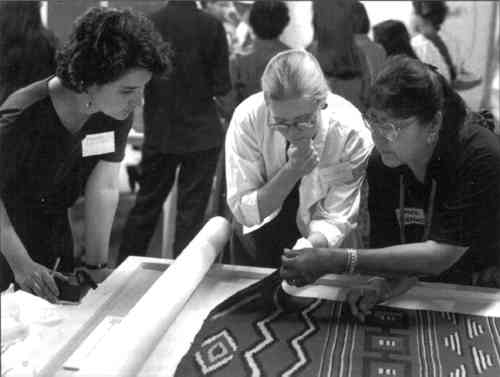WOVEN BY THE GRANDMOTHERS: TWENTY-FOUR BLANKETS TRAVEL TO THE NAVAJO NATIONSUSAN HEALD, & KATHLEEN E. ASH-MILBY
4 THE WORKSHOPCreating access to the textiles through the workshop was the primary purpose of bringing the blankets to Tsaile. Although many weavers may have access to Navajo weavings in New Mexico and Arizona museums, only some have the opportunity to study old blankets of this type closely. Additionally, the workshop environment encouraged group discussion and interaction, presenting an opportunity for exchange of knowledge between NMAI staff and weavers (fig. 4, p. 341). It was planned that information gathered would become primary source material for the exhibition Woven by the Grandmothers.
The workshop was originally scheduled for two days following the close of the display. However, local press coverage of the display was late, causing community interest to gain momentum just as the show was about to close. In order to allow more visitors to see the blankets, we decided to extend the display to run concurrently with both workshop days. This decision complicated the logistics of the workshop—How could we now keep the second day exclusive to invited weavers?—and reintroduced the handling issue. When some invited weavers arrived two days early, and others filtered in often accompanied by various generations of their families, we quickly dropped any plans for restricting the access or abiding by our carefully choreographed schedules. We were working in the Navajo community where flexibility, diplomacy, and reciprocity were essential as we adjusted to Navajo ways. In fact, we were already regretting that we did not plan for a longer visit. Approximately 80 people participated in the two days of the workshop. All participants were asked for permission to be included in the museum's documentation, consisting of photography, video, and audio recording, as well as conventional note taking by staff. Those who did not want to be recorded in any way were identified by a color-coded name tag to visually inform staff of their decision. Each workshop day began early with a Navajo blessing for the blankets and participants, followed by a welcome and introduction by Walters. Interpretation in both English and Navajo was given throughout the event by museum staff, advisers to the project, and volunteers, some of whom also assisted as handlers. NMAI's conservator presented a standard museum-handling orientation and explained how to use head loupes, probes, and linen testers. Weavers were given the option of using white cotton gloves or making sure their hands were clean before handling. About one-quarter of the weavers chose to wear the gloves. Many weavers dressed in their finest, with beautiful turquoise and silver jewelry, to attend this special event. We felt it was inappropriate to ask participants to remove their jewelry before handling the textiles. Weavers selected blankets they wanted to examine. The gateleg of a slant board was then collapsed, and the mounted textile was carried into the adjacent workshop room. The textile mount assemblage was placed flat on a table for examination. The workshop room was large enough to accommodate the study of two textiles at a time. Additionally, analysis sheets with information on yarn and fabric structure, dye analyses, and estimated dates of fabrication were posted in the room, and copies were given to interested parties. These analysis sheets, based on research by the late Southwest textile specialist, Joe Ben Wheat, were the focus of discussion and debate (Bonar et al. 1996, 181–95). Some weavers disagreed with attributed mid-19th-century dates because the textiles were in such good condition. Others found results of the dye analysis hard to believe, since red yarns identified as cochineal were very bright in color, appearing more like synthetic-dyed yarn. During the workshop, no textile ever left the support of its mount, though corners and sides were turned over and weaving details scrutinized. A few detached yarn fragments were found on the slant boards during the final packing. Most of these yarns were from augmented corner tassels. Several small fragments were from weak selvage cords. Detached fragments were saved and later placed in the textile's conservation file. The losses were fewer than anticipated and seemed minuscule compared with the emotional response of the participants. |
